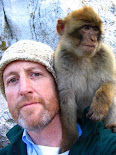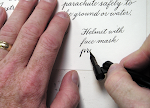
The tall shaggy creatures of
Yuocland arrived from their high pastures to attend the opening of the Verne/Dinotopia exhibition.

Also there were performances by the eccentric troupe
Gramoulinophone.
A few regular visitor/commentators to Gurney Journey made the trip. At left: Jeanette, me, "
Dragonladych," "
cegebe," Dragonlady's mom, and Jerome. Later I met
John Howe for the first time, and I greatly admire his work.

The new passageway between the two museum spaces was opened with speeches and giant balloons, which were kept aloft by many hands until they popped with dull booms.

Inside Maison d'Ailleurs was the exhibition "
Retour à Dinotopia," with 53 new paintings from
Journey to Chandara. (Photo above by Olivier Allenspach). The exhibit filled three floors of the museum, with maps blown up to gigantic size on the floors, and with films, miniatures, and behind-the-scenes panels. The show will be on view until March 8, 2009.

But the really big event was the opening of the new
Espace Jules Verne, the preeminent museum collection of Verniana. When you cross the new passageway, you enter the adjoining building in what looks like a large library, with thousands of rare editions of Jules Verne and his followers, as well as American pulp magazines and posters.
Museum director Patrick Gyger shows me one of the glass cases of model vehicles from the various Verne novels.

The collection was generously donated by the Jean-Michel Margot, originally from Switzerland, and now living in North Carolina. I had the privilege of sitting with him for a supper of stag stew, and did this quick portrait.

I also made this on-the-spot sketch in the style of an old poster of Maison d'Ailleurs, the world's most wonderful departure point for extraordinary journeys.
 Here are two paintings by two friends, painting side by side from the same motif.
Here are two paintings by two friends, painting side by side from the same motif.




































